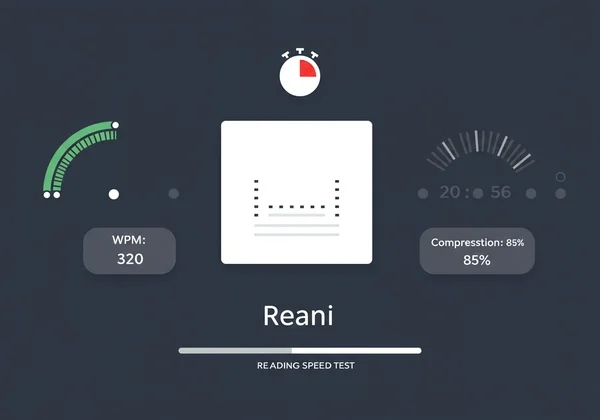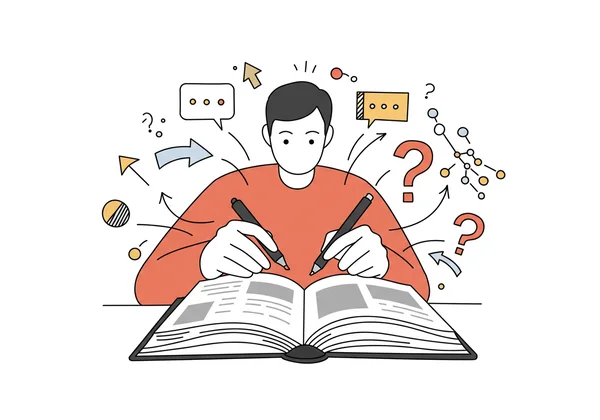Improve Your Reading Speed: A 4-Week WPM Test Training Plan
In an era of endless information, the ability to read quickly and effectively is no longer a luxury—it's a superpower. For students facing mountains of textbooks, professionals drowning in reports, and lifelong learners with an insatiable curiosity, time is the most precious resource. This is where you can learn speed reading. But how can I improve my reading speed and comprehension in a way that sticks? Forget unrealistic promises; this is your practical, four-week training plan to double your reading efficiency. Before you start, the first step is to establish a benchmark by taking a free reading speed test to discover your starting point.

The Science & Benefits of Mastering Your Reading Pace
Before diving into techniques, it’s crucial to understand what holds you back and what you stand to gain. Most of us were taught to read in a way that prioritizes accuracy over efficiency, but those foundational habits often become bottlenecks as we mature. By understanding the science behind reading, you can systematically dismantle these barriers.
Unpacking Traditional Reading Habits: Fixations & Subvocalization
Two main culprits slow down the average reader: fixations and subvocalization. Fixations are the tiny pauses your eyes make as they jump from one word to another. Inefficient readers fixate on every single word. Subvocalization is the habit of silently pronouncing each word in your head as you read. This "inner voice" limits your reading speed to your talking speed, creating an artificial ceiling on your potential. Breaking these habits is the first major step in your speed reading training.
Tangible Advantages: How Faster Reading Boosts Productivity & Learning
Imagine cutting your study time in half while retaining more information. Picture yourself clearing your inbox and daily reports before lunch. When you learn to read faster, these aren't just dreams. The benefits are concrete: students can cover more material for exams, professionals can make quicker, more informed decisions, and curious minds can explore twice as many books. This isn't about rushing; it's about processing information with greater efficiency and less mental fatigue.
Your Baseline: Accurately Measuring Your Current Reading Speed (WPM)
You can't improve what you don't measure. Before embarking on this 4-week journey, you must know your current words per minute (WPM) and comprehension level. This baseline is your starting line, the metric you will use to track your progress and celebrate your victories. A generic timer isn't enough; you need a tool that provides a holistic view of your abilities.
Why a Comprehensive Reading Speed Test is Crucial
Speed without understanding is just scanning. A truly valuable assessment measures two things: how fast you read and how much you comprehend. This dual evaluation is the core of effective reading. It prevents you from developing the bad habit of skimming without absorbing key details. A quality wpm test is a comprehensive reading speed test that provides you with a WPM score and a comprehension percentage, giving you a complete picture of your effective reading speed.

Interpreting Your Results: What's an Average Reading Pace?
So, you've taken the test. What do the numbers mean? The average reading pace for most adults is between 200 and 250 WPM with about 70-80% comprehension. Highly educated individuals like professors might read closer to 350-400 WPM. Don't be discouraged by your initial score. The purpose of this number is not to judge but to set a clear, measurable goal for improvement. With consistent practice, doubling your initial score is a very achievable target.
The 4-Week Speed Reading Training Plan: Your Weekly Roadmap
This is where your transformation begins. Dedicate 15-20 minutes each day to these exercises. Consistency is far more important than intensity. Remember to check your reading pace at the start and end of each week to see the tangible results of your efforts.
Week 1: Eliminating Efficiency Blockers (Subvocalization & Regression)
This week is all about breaking old habits. Your primary focus is to quiet that inner voice and stop unnecessary re-reading.
-
Tackle Subvocalization: While you read, try humming softly to yourself or chewing gum. This occupies the muscles and mental pathways used for silent speech, making it harder to subvocalize. It will feel awkward at first, but this drill retrains your brain to process words visually, not auditorily.
-
Prevent Regression: Regression is the act of unconsciously letting your eyes jump back to words you've already read. Use a pacer—your finger, a pen, or a cursor—and glide it smoothly under each line of text. Force your eyes to keep up with the pacer. This simple trick dramatically reduces backtracking and builds forward momentum.

Week 2: Expanding Your Visual Span & Eye Movements
Now that you're silencing your inner monologue, it's time to train your eyes to see more with each glance. Instead of reading word-by-word, you'll learn to read in chunks.
- Word Grouping: Start by trying to see two words at a time with each fixation. As you get comfortable, push yourself to see three or four. The goal is to reduce the number of eye stops per line.
- Soft Focus: Relax your gaze and look at the center of the page, using your peripheral vision to see words at the beginning and end of lines. This technique helps you take in whole phrases at once, significantly boosting your how to increase reading speed.
Week 3: Boosting Comprehension & Retention with Active Reading
This week, we ensure your understanding keeps pace with your speed. Active reading is about engaging with the text, not just passively receiving it.
-
Preview the Material: Before you start reading an article or chapter, spend 30 seconds scanning it. Look at headings, bolded words, and the first sentence of each paragraph. This creates a mental map that helps your brain organize the information as you read.
-
Ask Questions: Turn headings into questions. If a section is titled "The Industrial Revolution," ask yourself, "What were the key impacts of the Industrial Revolution?" This turns reading into a mission to find answers, which dramatically improves focus and retention.

Week 4: Integrating Advanced Techniques & Sustained Practice
In the final week, you'll learn to adapt your speed to different types of material and solidify your practice for long-term success.
- Skimming and Scanning: Skimming is reading rapidly to get a general overview. Scanning is looking for a specific piece of information. Practice these on newspapers or blog posts. Learn when to speed up (familiar topics, simple arguments) and when to slow down (complex data, dense academic text).
- Solidify Your Habit: You've built a strong foundation. The key now is consistency. Make your 15-minute practice a non-negotiable part of your day. The more you use your new skills, the more natural they will become. Measure your progress one last time to see how far you've come.
Sustaining Momentum: Beyond the 4 Weeks
Congratulations on completing the 4-week plan! Your journey isn't over; it's just beginning. Like any skill, speed reading requires maintenance to stay sharp. The goal is to integrate these techniques so seamlessly that they become your new normal way of reading.
The Role of Consistent Practice in Reading Skill Development
Think of speed reading like a muscle. If you stop working it out, it will weaken over time. Continue to use a pacer for challenging texts and consciously practice reading in word groups. Make it a game to see how quickly you can get the gist of an article. The more you practice, the less you'll have to think about it.
Why Regular WPM Tests are Your Best Progress Tracker
Motivation can wane without feedback. That’s why using a periodic reading speed test is so powerful. Taking a free reading speed test once a month serves as a valuable check-in. It provides objective data on your performance, reminds you of how much you've improved, and highlights areas where you might need to refocus your practice. It is your best tool for long-term growth.
Your Next Step: Embrace Faster, Smarter Reading
You now have a proven, actionable guide to fundamentally change the way you read. Over four weeks, you can break lifelong habits, train your eyes and brain to work more efficiently, and unlock hours of productive time. The key is to start, stay consistent, and track your progress.
Ready to uncover your reading potential? The first step is knowing where you stand. Take the free reading speed test on our homepage today and begin your transformation from a passive reader to an efficient, active learner.
Frequently Asked Questions About Speed Reading
What is a good reading speed (WPM) to aim for?
While the average is around 200-250 WPM, a "good" speed depends on your goals. A solid initial target for most people is to double their current speed while maintaining or improving comprehension. Aiming for 400-500 WPM is an excellent and achievable goal for effective reading of most materials.
How can I improve my reading speed and comprehension simultaneously?
The key is balance. Use techniques like the pacer method to push your speed, but integrate active reading strategies like previewing and questioning to boost comprehension. A dual-assessment tool, like our reading comprehension test, is essential for ensuring one doesn't come at the expense of the other.
How do I stop subvocalization when reading?
Stopping subvocalization involves distracting the part of your brain that "speaks" the words. You can do this by gently humming, chewing gum, or even counting "1-2-3-4" in your head as you read. This feels strange initially but is highly effective at breaking the habit.
Is it truly possible to read at 1000 WPM?
Reading at 1000+ WPM is possible, but it typically involves advanced skimming techniques rather than traditional reading. At such speeds, detailed comprehension of complex material often decreases. For most people, a more practical and valuable goal is to achieve a highly efficient 400-600 WPM with strong retention.